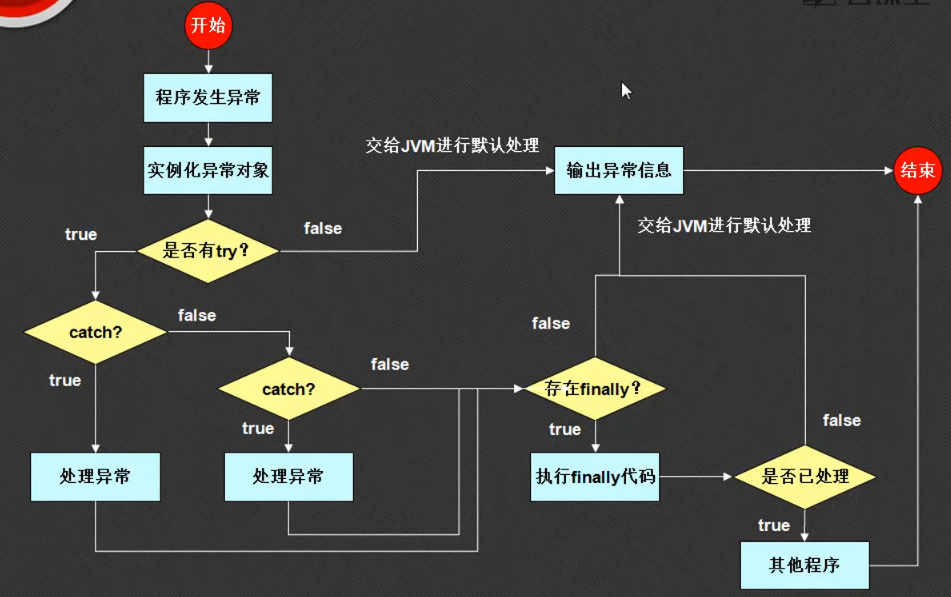1、异常的产生以及对程序的影响
10/0 异常产生后,打印出异常信息,中断程序的继续执行。
我们要做的就是即使异常也要让程序继续正确的执行下去。
2、异常处理的格式
try{ //有可能出现异常的代码 }[catch(异常类型 对象){ //异常处理 } catch(异常类型 对象){ //异常处理 } catch(异常类型 对象){ //异常处理 }…] [finally]{ //不管是否出现异常,都会同一执行的代码 }
组合try…catch 、try…catch…finally、try…finally
public class TestException
{
public static void main(String[] args)
{
System.out.println("除法开始。。。");
try
{
System.out.println("除法开始进行:"+10/0);
}catch(ArithmeticException e){
System.out.println("******出现异常了*****");
}
System.out.println("除法结束。。。");
}
}
除法开始。。。 ******出现异常了***** 除法结束。。。
下面可以打印出异常的信息。(try…catch)
package exception;
public class TestException
{
public static void main(String[] args)
{
System.out.println("除法开始。。。");
try
{
System.out.println("除法开始进行:"+10/0);
}catch(ArithmeticException e){
e.printStackTrace();
}
System.out.println("除法结束。。。");
}
}
除法开始。。。 java.lang.ArithmeticException: / by zero at exception.TestException.main(TestException.java:10) 除法结束。。。
使用:(try…catch…finally)
package exception;
/**
* 对产生的异常简单处理,打印出异常信息
* 2017-09-11
* @author Junwei Zhu
*
*/
public class TestException
{
public static void main(String[] args)
{
System.out.println("除法开始。。。");
try
{
System.out.println("除法开始进行:"+10/0);
}catch(ArithmeticException e){
e.printStackTrace();
}finally {
System.out.println("***这是finally语句,不管是否出现异常都会执行***");
}
System.out.println("除法结束。。。");
}
}
除法开始。。。 java.lang.ArithmeticException: / by zero at exception.TestException.main(TestException.java:15) ***这是finally语句,不管是否出现异常都会执行*** 除法结束。。。
除法的两个数由args[]参数决定
package exception;
/**
* 对产生的异常简单处理,打印出异常信息
* 2017-09-11
* @author Junwei Zhu
*
*/
public class TestException
{
public static void main(String[] args)
{
System.out.println("除法开始。。。");
try
{
int x = Integer.parseInt(args[0]);
int y = Integer.parseInt(args[1]);
System.out.println("除法开始进行:"+x/y);
}catch(ArithmeticException e){
e.printStackTrace();
}finally {
System.out.println("***这是finally语句,不管是否出现异常都会执行***");
}
System.out.println("除法结束。。。");
}
}
除法开始。。。 ***这是finally语句,不管是否出现异常都会执行*** Exception in thread "main" java.lang.ArrayIndexOutOfBoundsException: 0 at exception.TestException.main(TestException.java:15) 【数组越界】
请解释Error和Exception的区别?
Error:是JVM错误,即:此时的程序还没有执行,如果没有执行用户无法处理;
Exception:指的是程序运行中产生的异常,用户可以处理。
3、异常的处理流程

用Exception处理所有的异常。
package exception;
/**
* 对产生的异常简单处理,打印出异常信息
* 2017-09-11
* @author Junwei Zhu
*
*/
public class TestException
{
public static void main(String[] args)
{
System.out.println("除法开始。。。");
try
{
System.out.println("除法开始进行:"+10/0);
}catch(Exception e){
e.printStackTrace();
}finally {
System.out.println("***这是finally语句,不管是否出现异常都会执行***");
}
System.out.println("除法结束。。。");
}
}
在开发中异常分类处理。
4、throw、throws关键字的使用
throws关键字
主要用于方法声明上,指的是当方法之中出现异常后交由被调用出处理。
package throwsTest;
class MyMath
{
public static int div(int x,int y)throws Exception{
return x/y;
}
}
public class TestThrows
{
public static void main(String[] args)
{
//调用了throws声明的方法之后,那么不管操作是否出现异常,必须使用try...catch
//进行异常的处理
try {
System.out.println(MyMath.div(10, 2));
} catch (Exception e) {
e.printStackTrace();
}
}
}
throw关键字
在程序之中可以直接使用throw手工的抛出一个异常类的实例化对象。
package throwTest;
public class TestThrow
{
public static void main(String[] args)
{
try {
throw new Exception("自己定义的异常");
} catch (Exception e) {
e.printStackTrace();
}
}
}
java.lang.Exception: 自己定义的异常 at throwTest.TestThrow.main(TestThrow.java:8)
请解释throw和throws的区别?
throw:指的是在方法之中人为抛出一个异常类对象(这个异常类的对象)
throws:在方法的声明上使用,表示此方法在调用时必须处理异常。
5、异常处理的使用标准
重要的代码模型:异常的使用格式
定义的一个div()方法,要求:这个方法在进行计算之前打印提示信息,在计算结束完毕也打印提示信息,如果在计算之中产生了异常,则交给被调用处进行处理。
package exception;
class MyMath
{
public static int div(int a,int b) throws Exception
{
int result = 0;
System.out.println("计算开始。。。");
try{
result = a/b;
}catch(Exception e){
e.printStackTrace();
}finally {
System.out.println("计算结束。。。");
}
return result ;
}
}
public class TestDemo
{
public static void main(String[] args)
{
try {
System.out.println(MyMath.div(10, 0));
} catch (Exception e) {
e.printStackTrace();
}
}
}
计算开始。。。 java.lang.ArithmeticException: / by zero at exception.MyMath.div(TestDemo.java:10) at exception.TestDemo.main(TestDemo.java:24) 计算结束。。。 0
请解释Exception和RuntimeException的区别?请列举出几个你常见的RuntimeException;
使用定义的异常必须要被处理,而RuntimeException异常可以选择性处理。
常见的RuntimeException:ArithmeticException、NullPointerException、ClassCaseException